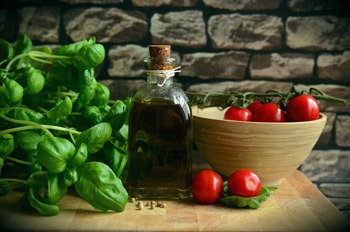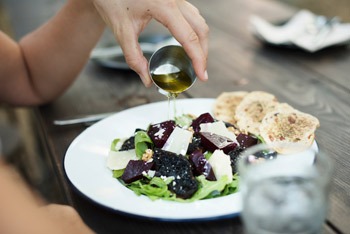 Olive Oil has many virtues. Our palate enjoys its flavor and aromas, but above all, many scientific studies have confirmed and proven its healthy properties.
Olive Oil has many virtues. Our palate enjoys its flavor and aromas, but above all, many scientific studies have confirmed and proven its healthy properties.
It is a very complex food. The simple transformation of olives into oil brings out organoleptic and chemical components. Individual varietal characteristics, correct harvesting procedures, timing and milling (pressing in specialized mills) are all key components that involved in final product quality.
The quality of an Olive Oil is then reflected and confirmed with low acid content and more specifically, the quality is held in the organoleptic characteristics.
In Italy, Olive Oil is an important cuisine element. Today, there is increasing attention on quality, and consumers are ever more knowledgeable and appreciate the presence of Olive Oil in the Mediterranean Diet (It has become one of UNESCO’s intangible assets).
 Olive Oil contains substances such as carotene, tocopherols, phospholipids and unsaturated fatty acids and proteins that protect and assist the human body: Olive Oil is easily digestible and helps with the digestive process.
Olive Oil contains substances such as carotene, tocopherols, phospholipids and unsaturated fatty acids and proteins that protect and assist the human body: Olive Oil is easily digestible and helps with the digestive process.
There are several types of Olive Oil On the market, but the best one par excellence is the Extra Virgin Olive Oil. It is called Extra Virgin Olive Oil based on if the oil comes from the first press of the olives and if the oil does not exceed 0,8% of oleic acid content.
The quality of the raw material, the Olives themselves, begin the quality process. Only fresh and top quality olives should be used in Extra Virgin Olive Oil: handpicked, sprigs and leaves separated out without having undergone any other treatment other than having been washed and placed in a quality olive oil mill for its first press.
Extra Virgin Olive Oil is healthy and recommended to everyone, kids and adults:
- rich in oleic acid, olive oil is excellent for children and is indispensable for growth;
- for people who practice sports, Olive Oil is a source of easily digestible energy;
- for the elderly, olive oil helps limit the loss of calcium in the bones and is rich in vegetable unsaturated fats that give energy healthy nutrients to our body.
Above and beyond the healthy features of Extra Virgin Olive Oil, olive oil gives flavor to our food. To better appreciate and assimilate its qualities we suggest you to use it raw as a condiment on bruschetta, soups, legumes, salads, meats and it is can also be used cooked in all our meals and can even be used for fried dishes.
How to preserve the Extra Virgin Olive Oil
Extra Virgin Olive Oil is at its best, with its most typical qualities and characteristics when consumed raw within 4-8 months of pressing. After 8- 12 months, the fragrance, the freshness and the taste change slightly: the Olive Oil does not get worse, but it can lose some qualities such as vitamin E and other antioxidant contents. Heat, temperature excursions, oxygen and direct sun light cause olive to rapidly oxidize. Extra Virgin Olive Oil should always be stored in a dark, well-closed glass container, at a stable temperature of approximately 14° C.
Sources: Consorzio Olio Extravergine di Toscana and Consorzio dell’Olio Toscano IGP









